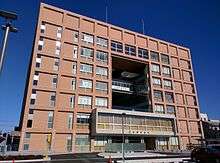Sano, Tochigi
| Sano 佐野市 | |||
|---|---|---|---|
| City | |||
|
The former Sano City Hall, demolished following damage in the 2011 earthquake | |||
| |||
 Location of Sano in Tochigi Prefecture | |||
 Sano
| |||
| Coordinates: 36°18′52.2″N 139°34′42″E / 36.314500°N 139.57833°ECoordinates: 36°18′52.2″N 139°34′42″E / 36.314500°N 139.57833°E | |||
| Country | Japan | ||
| Region | Kantō | ||
| Prefecture | Tochigi Prefecture | ||
| Government | |||
| • Mayor | Masahide Okabe (since April 2005) | ||
| Area | |||
| • Total | 356.04 km2 (137.47 sq mi) | ||
| Population (May 2015) | |||
| • Total | 117,970 | ||
| • Density | 331/km2 (860/sq mi) | ||
| Time zone | Japan Standard Time (UTC+9) | ||
| - Tree | Pine | ||
| - Flower | Katakuri | ||
| - Bird | Mandarin Duck | ||
| Phone number | 0283-24-5111 | ||
| Address | 1, Takasagochō, Sano-shi, Tochigi-ken 327-0022 | ||
| Website | Official website | ||

Sano (佐野市 Sano-shi) is a city located in Tochigi Prefecture, in the northern Kantō region of Japan. As of May 2015, the city had an estimated population of 117,970 and a population density of 331 persons per km². Its total area was 356.04 km². The city is known for its Outlet Mall, Sano Yakuyoke Daishi Temple, and its local variety of ramen.
Geography
Sano is located in southwestern Tochigi Prefecture, bordered by Gunma Prefecture to the west.
Surrounding municipalities
History
During the Edo period, Sano was a castle town and the seat of the daimyo of Sano Domain. Following the Meiji restoration, the town of Sano was created within Aso District, Tochigi with the establishment of the municipalities system on April 1, 1889.
Sano was elevated to city status on April 1, 1943 when it merged with the neighboring towns of Inubushi and Horigome and the villages of Sakai and Hatagawa. The city annexed the village of Inazuma (from Ashikaga District) on January 1, 1955 followed by the town of Akami(from Aso District) on April 1, 1955.
On February 28, 2005 Sano absorbed the towns of Kuzu and Tanuma (both from Aso District).
Economy
Agriculture and light manufacturing are mainstays of the local economy, with production of Kanpyō, turmeric and spinach being prominent local crops. The city is increasingly a bedroom community for neighboring Utsunomiya.
Education
- Sano College
- Sano also has 28 primary schools, 11 middle schools and eight high schools.
Sports
Sano also has become the headquarters of the Japan Cricket Association and has hosted a number of cricket games between international teams. On March 22, 2016, it was announced that Sano would be home to the Sano International Cricket Ground, which will become Japan's first dedicated cricketing venue built for purpose which no longer has to compete with other sports for usage.[1]
Transportation
Railway
Highway
- Tōhoku Expressway – Sano-Fujioka IC, Sano PZ
- Kita-Kantō Expressway – Izuruhara PA, Sano-Tanuma IC
- Japan National Route 50
- Japan National Route 293
Local attractions
- house of Shōzō Tanaka
- site of Sano Castle
International relations
-
 Lancaster, Pennsylvania, United States[2]
Lancaster, Pennsylvania, United States[2] -
 Quzhou, China, friendship city since 1997 [3]
Quzhou, China, friendship city since 1997 [3]
Noted people from Sano
- Shōzō Tanaka – politician, social activist
- Takuro Ishii – professional baseball player
- Tatsuya Ozeki – professional baseball player
- Shunsuke Ishikawa – professional baseball player
- Kyogo Kawaguchi – singer-songwriter
References
- ↑ "International Cricket Ground to be built in Japan". Japan Cricket Association. March 23, 2016. Retrieved March 23, 2016.
- ↑ Wallace, Brian (2009-05-04). "SDL scraps trip to Japan at request of Japanese officials concerned about the flu". Intelligencer Journal. Retrieved 2009-05-08.
- ↑ Quzhou government information
External links
![]() Media related to Sano, Tochigi at Wikimedia Commons
Media related to Sano, Tochigi at Wikimedia Commons
- Official website (Japanese)



